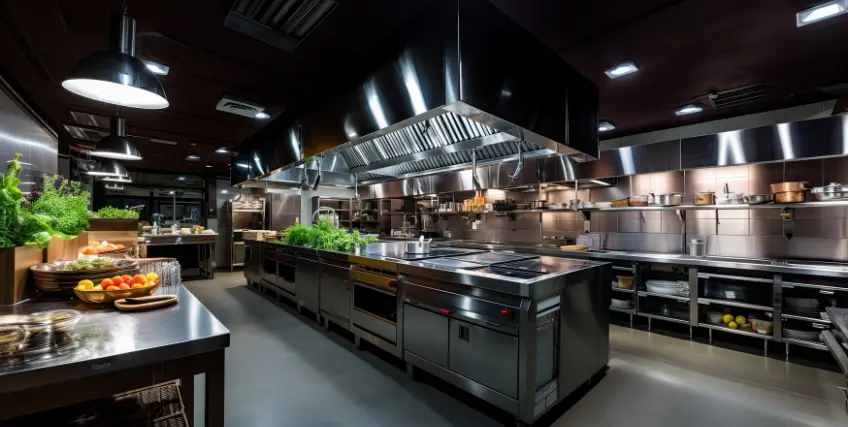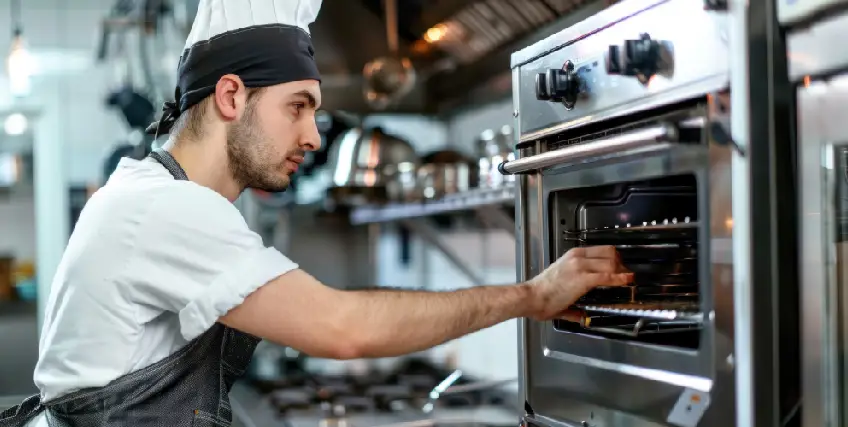Your Guide to Restaurant Equipment Maintenance, Repairs and Financing
April 02, 2025 | Last Updated on: April 02, 2025

Restaurant equipment plays a crucial role in the daily operations of restaurants, diners, and fast-food locations. Reliable equipment keeps food preparation efficient, maintains quality, and ensures customer satisfaction. Neglecting maintenance leads to breakdowns, unexpected costs, and lost revenue. A solid maintenance plan helps avoid these issues and keeps your business running smoothly. Learn more about maintenance for commercial kitchen appliances, how to pay for repairs and maintenance, and when it makes sense to replace instead of repair restaurant equipment.
Typical Commercial Restaurant Equipment
Every restaurant depends on specialized equipment to prepare, store, and serve food. Keeping these tools in good condition prevents downtime and expensive replacements. Here are some of the typical kitchen restaurant equipment in the food service industry.
- Kitchen Appliances: Cooking equipment includes heavy duty ovens, convection ovens and stoves, deep fryers, charbroilers, griddles, and grills. They must function properly to keep up with high-demand cooking. Regular cleaning and inspections prevent malfunctions. Stainless steel appliances and cookware are often easier to clean and maintain.
- Commercial Refrigeration Equipment: Walk-in coolers and freezers offer food storage for perishable items. A reach-in refrigerator provides quick access, especially if there's a glass door to easily locate items. Faulty units can lead to spoiled food and lost revenue. Check temperature settings and clean condenser coils to ensure efficiency.
- Ice Machines: Commercial ice machines and ice makers provide a constant flow of ice for workers and customers. Many soda fountains include ice machines for customer use. While workers may require a reach-in freezer for storage or a commercial-grade ice machine for food prep.
- Dishwashers and Cleaning Equipment: Clean plates and utensils are essential for food safety. Routine maintenance prevents breakdowns that can slow service.
- Food Preparation Tools: Dispensers, mixers, slicers, and blenders speed up food prep on countertops and prep tables. Dull blades or worn parts reduce efficiency and can be hazardous.
- Point-of-Sale (POS) Systems: These point-of-sale systems process orders and payments. A malfunctioning POS disrupts business and frustrates customers.
As a restaurant owner, the style and look of your restaurant can be as important as the quality of your food. Explore restaurant furniture supply stores to create your dream restaurant design. Think about the experience you want for your customers. Is it a fast-casual location where customers are in and out quickly, or does your restaurant encourage guests to linger and enjoy multiple courses, including after dinner desserts, coffee, and drinks?
Equipment for Specialty Cuisines and Dishes
If your restaurant serves different cuisines, you may need specialty restaurant equipment in order to prepare those dishes. For example, you may need tandoor ovens, BBQ smokers, or specialty sushi knives and work tables. Brewers and ice cream shops also need specific equipment that other restaurants may not have.
Commercial catering equipment may also be necessary if you operate a food truck or cater events outside your restaurant.
The Benefits of Regular Maintenance
Equipment maintenance keeps your restaurant operating efficiently and prevents major issues. Follow appliance guidelines and industry best practices to keep your commercial kitchen equipment from breaking down.
- Avoid Unexpected Breakdowns: Malfunctioning equipment slows down service, leads to wasted food, and frustrates staff. Regular maintenance minimizes the risk of sudden failures.
- Ensure Safety and Compliance: Poorly maintained equipment can cause safety hazards. Keeping everything in good condition helps you meet health regulations and avoid fines.
- Lower Repair and Replacement Costs: Preventative maintenance extends the life of restaurant equipment. Addressing minor issues early prevents costly repairs or replacements.
- Improve Energy Efficiency: Clean and well-maintained appliances use less energy. When purchasing equipment, look for Energy Star ratings to identify more efficient appliances. This lowers utility bills and reduces your restaurant's environmental impact.
Should You Repair or Replace Equipment?
Deciding whether to repair or replace restaurant equipment depends on several factors. Frequent breakdowns, increasing repair costs, and declining performance indicate that replacement may be necessary.
If repair costs exceed half the price of a new unit, replacing the equipment is often the better choice. Checking warranties and service contracts can help reduce repair expenses. Some manufacturers cover parts and labor for a specific period, making repairs more cost-effective.
Energy efficiency is another critical factor. Newer models use less power and operate more efficiently, which lowers long-term operating costs. Weighing these considerations helps you make a financially sound decision.
How to Pay for Equipment Repairs
Equipment repairs can be expensive, but several financing options can help. Choose the financing option that matches your cash flow to avoid unnecessary strain on your budget.
Use Business Savings
Setting aside funds for maintenance reduces the financial impact of unexpected repairs. Allocating a portion of profits to an emergency repair fund prevents service disruptions. Consider putting the money into a high-yield business savings account or certificate of deposit (CD) to earn interest when the money isn't being used.
Apply for a Business Loan
Short-term business loans provide quick cash to cover repair expenses. Lenders offer various loan options tailored to restaurant owners needing immediate financial assistance. Most business loans offer fixed interest rates with stable monthly payments. This makes it easier to budget and keep payments current.
SBA Loan
Small Business Administration (SBA) loans are offered by traditional banks, credit unions, and online lenders. These loans can be used to pay for equipment repairs, buy new equipment, or expand your business. SBA loans are often available to borrowers who cannot get approved for conventional loans. These loans are ideal for startups or borrowers with lower credit scores or uneven profitability.
Use a Line of Credit
A business line of credit offers flexibility for ongoing repair costs. Unlike a loan, you only borrow what you need and pay interest on the amount used. As you repay the balance, your available credit increases up to your maximum credit limit. This allows you to borrow money repeatedly without having to apply for a new loan. However, business lines of credit have variable interest rates, which can increase your interest expenses in a rising rate environment.
Business Credit Card
A business credit card is a revolving line of credit that business owners use for everyday business expenses. This type of loan is excellent for short-term purchases that are repaid quickly. Otherwise, the high interest rates can lead to a cycle of debt that is hard to escape.
Many business credit cards also offer rewards and other valuable benefits. Some cards offer a welcome bonus or intro APR offer when opening a new account. Intro APRs on purchases allow you to pay for new restaurant equipment or repairs over time without incurring interest charges.
Financing New Restaurant Equipment
Upgrading or replacing restaurant equipment requires careful financial planning. While you can often use the same types of loans for maintenance when buying new equipment, there are two types of loans you should also be aware of. Leases and equipment loans are single-purpose loans that are secured by specific equipment.
Leasing Equipment
Leasing allows you to use new equipment without a large upfront payment. It provides flexibility to upgrade when needed. Monthly lease payments can be easier to manage than large lump-sum purchases. At the end of the lease, you may have the option to buy the equipment, extend the lease, or return it.
Equipment Loans
Purchasing equipment through a loan gives you ownership while spreading payments over time. This option is ideal if you plan to use the equipment long-term. Equipment loan terms vary, so comparing interest rates, repayment schedules, and eligibility requirements is essential before committing.
Creating a Maintenance Plan
A structured maintenance plan keeps restaurant equipment in top shape and minimizes downtime.
- Schedule Routine Inspections: Regularly check equipment for wear and tear. Identify issues before they become costly problems.
- Train Staff on Maintenance Tasks: Employees should clean and inspect equipment daily. Assign responsibilities to ensure consistency.
- Work with Reliable Service Providers: Establish relationships with trusted repair technicians. Service contracts can provide routine maintenance at a predictable cost.
The Bottom Line About Restaurant Equipment Maintenance
Investing in proper maintenance ensures that your restaurant equipment operates efficiently, saving you money and keeping your business running smoothly. Planning for repairs and replacements in advance can prevent disruptions and maintain high service standards. Take the time to assess your current maintenance practices and implement improvements where needed. If you don't have the money to pay for repairs and maintenance, evaluate financing options that allow you to spread the cost over time. When repairs are too costly, consider replacing the equipment with a newer, more efficient and reliable model.
Frequently Asked Questions (FAQs)
What is a Restaurant Equipment Maintenance Checklist?
An equipment maintenance checklist provides a simple course of action for all employees to follow, whether they are new to the job or are your most experienced workers. It outlines the tasks and inspections to follow for each piece of equipment at the end of every shift to keep it in optimal running condition.
How Much Does Restaurant Equipment Maintenance Cost?
The cost of restaurant equipment maintenance varies based on how much equipment you have and its age. On average, you can expect to spend between $500 and $2,500 per month on repair and maintenance for each location of your restaurant.
What are Six Common Preventative Maintenance Checks?
Each restaurant owner handles preventative maintenance differently, but there are six common tasks that everyone should perform. These checks include scheduling preventative maintenance, document services and repairs, use checklists, clean regularly, customize maintenance for each machine, and train employees how to use machines properly.
What Does Daily Restaurant Equipment Maintenance Include?
Aside from cleaning your restaurant equipment, there are a few tasks you should perform daily to ensure your equipment performs efficiently. These daily tasks include lubricating and adjusting machinery, inspecting for loose or deteriorating parts and replacing them when needed, and checking and testing safety equipment.
What is an Equipment Maintenance Plan?
A maintenance plan is an agreement with a third-party provider to maintain and repair restaurant equipment in exchange for a monthly retainer. These plans ensure your equipment stays in good condition for a fixed monthly fee. This allows restaurant owners to budget repairs and maintenance more effectively and reduces unexpected expenses.




